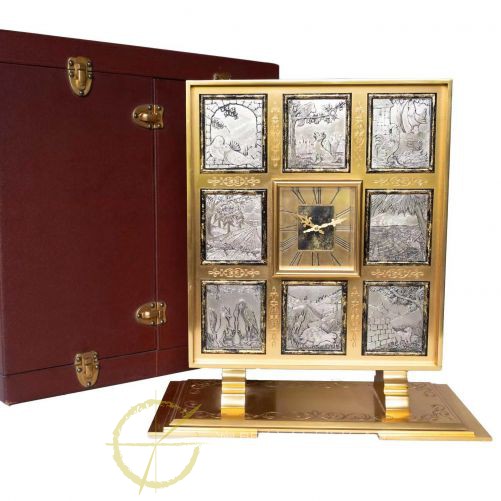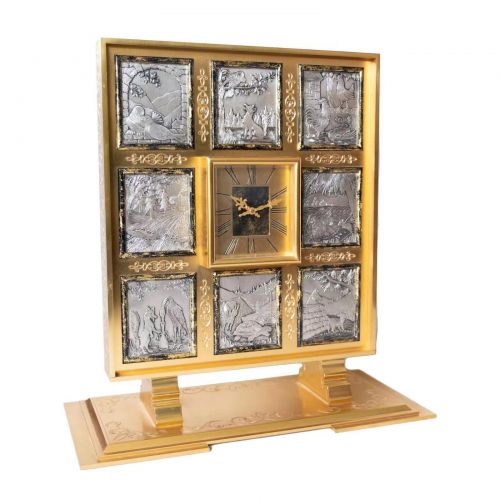Mid 20th Century Gubelin Fables Clock
Inventory Number: C2303001
Made circa the mid 20th century by Gübelin, 35.8 x 34 x 16.5 cm, gilt brass. The clock is divided equally into nine parts, with the dial in the center, surrounded by eight silver plates engraved of the fables by the famous French poet Jean de La Fontaine (1621-1695). 8-day going, straight-line lever escapement, movement No. 3192. It is accompanied by the original case.
The fables from left to right and top to bottom:
The Two Pigeons (2nd fable from Book IX, 1678);
The Raven and the Fox (2nd fable from Book I, 1668)
The Animals Sick of the Plague (1st fable from Book VII, 1678);
The Cicada and the Ant (1st fable of Book I, 1668);
The Lion and the Rat (11th fable of Book II, 1668);
The Fox and the Stork (18th fable of Book I, 1668);
The Hare and the Tortoise (10th fable from Book VI, 1668);
The Wolf and the Lamb (10th fable of Book I, 1668).
About Les Fables de La Fontaine
The numerous works of La Fontaine fall into three traditional divisions: the Fables, the Tales and the miscellaneous (including dramatic) works. He is best known for the first of these, in which a tradition of fable collecting in French verse reaching back to the Middle Ages was brought to a peak.
The publication of the twelve books of La Fontaine's Fables extended from 1668 to 1694. The stories in the first six of these derive for the most part from Aesop and Horace and are pithily told in free verse. The deceptively simple verses are easily memorized yet display deep insights into human nature. Many of the lines have entered the French language as standard phrases, often proverbial. The fables are also distinguished by their occasionally ironical ambivalence.
About GÜBELIN
In 1854, Mauritz Breitschmid opened a watchmaker's shop in Lucerne. In 1861, Eduard Jakob Gübelin was born in Eastern Switzerland. He subsequently moved to Lucerne and was apprenticed to the watchmaker Mauritz Breitschmid.
1886 marked a special occasion in the young watchmaker's life as Eduard Jakob Gübelin married Bertha Sophia Breitschmid, the daughter of his old master. In the same year, the two men became business partners, managing the growing company together.
In the 1920s Gübelin opened its own jewelry atelier and at the same time set up a small gemological laboratory so that it could test – and be sure of the authenticity – of the stones its jewelers used. It also continued making and repairing fine watches for a discerning clientele, developing a reputation that soon reached throughout Europe and overseas.
In 1923 Eduard Moritz Gübelin-Schriber, the son of Eduard Jakob Gübelin-Breitschmid, founded the gemological laboratory to check the quality of the gemstones internally. [4] In the same year, the Gübelin company also began to manufacture their own pieces of jewelry. These are created in the in-house jewelry studio.
In 1945 Walter Gübelin, the son of Eduard Moritz Gübelin-Schriber, took over the overall management of the company and the watch workshop. His brother, the gemologist Eduard Josef Gübelin, is responsible for the gemstones and communication. Eduard J. Gübelin was a pioneer in gemology and has repeatedly shown that he is a specialist in this field.







